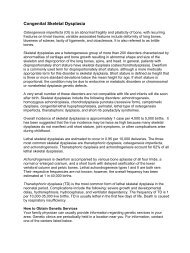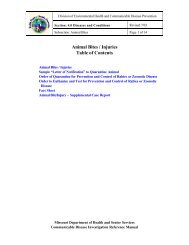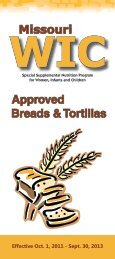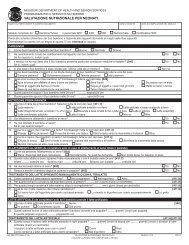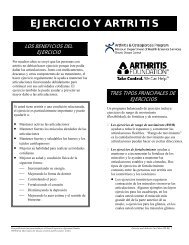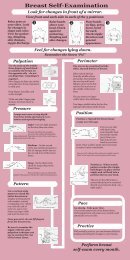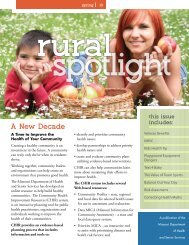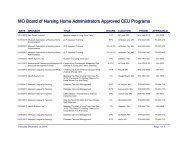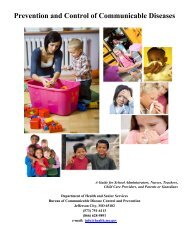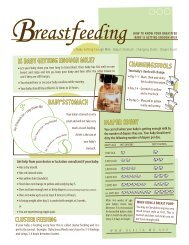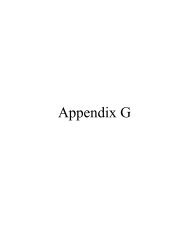category 4 a - oasis data set forms - Missouri Department of Health ...
category 4 a - oasis data set forms - Missouri Department of Health ...
category 4 a - oasis data set forms - Missouri Department of Health ...
Create successful ePaper yourself
Turn your PDF publications into a flip-book with our unique Google optimized e-Paper software.
prior OASIS wound item, then the wound is considered to be present for M1350, and the<br />
item would be answered "Yes."<br />
[Q&A EDITED 09/09; Formerly Q82]<br />
Q112.10. M1350. Is a new suprapubic catheter, new PEG site, or a new colostomy<br />
considered a wound or lesion?<br />
A112.10. A new suprapubic catheter site (cystostomy), new PEG site (gastrostomy)<br />
would be considered a skin lesion or wound at M1350, if there were receiving clinical<br />
intervention. Bowel ostomies are excluded from consideration in responding to M1350.<br />
Ostomies are not reported as surgical wounds in M1340, Does this patient have a<br />
Surgical Wound or M1342, Status <strong>of</strong> the Most Problematic (Observable) Surgical<br />
Wound.<br />
[Q&A EDITED 08/07; Formerly Q86]<br />
Q112.11. M1350. Are implanted infusion devices or venous access devices<br />
considered skin lesions at M1350?<br />
A112.11. If they are receiving clinical intervention by the home health agency and had<br />
not already be reported in a prior OASIS wound item.<br />
[Q&A EDITED 09/09]<br />
Q113. M1400. How should I best evaluate dyspnea for a chairfast (wheelchairbound)<br />
patient? For a bedbound patient?<br />
A113. M1400 asks when the patient is noticeably short <strong>of</strong> breath. In the response<br />
options, examples <strong>of</strong> shortness <strong>of</strong> breath with varying levels <strong>of</strong> exertion are presented.<br />
The chairfast patient can be assessed for level <strong>of</strong> dyspnea while performing ADLs or at<br />
rest. If the patient does not have shortness <strong>of</strong> breath with moderate exertion, then either<br />
response 0 or response 1 is appropriate. If the patient is not short <strong>of</strong> breath on the day<br />
<strong>of</strong> assessment, then response 0 applies. If the patient only becomes short <strong>of</strong> breath<br />
when engaging in physically demanding transfer activities, then response 1 seems most<br />
appropriate.<br />
In the case <strong>of</strong> the bedbound patient, the level <strong>of</strong> exertion that produces shortness <strong>of</strong><br />
breath should also be assessed. The examples <strong>of</strong> exertion given for responses 2, 3,<br />
and 4 also provide assessment examples. Response 0 would apply if the patient were<br />
never short <strong>of</strong> breath on the day <strong>of</strong> assessment. Response 1 would be most appropriate<br />
if demanding bed-mobility activities produce dyspnea.<br />
[Q&A ADDED 08/07; M item number updated 09/09Previously CMS OCCB 07/06 Q&A<br />
#31]<br />
Q113.1. M1400. What is the correct response for the patient who is only short <strong>of</strong><br />
breath when supine and requires the use <strong>of</strong> oxygen only at night, due to this<br />
positional dyspnea? The patient is not short <strong>of</strong> breath when walking more than 20<br />
feet or climbing stairs.<br />
A113.1. Since the patient’s supplemental oxygen use is not continuous, M1400 should<br />
reflect the level <strong>of</strong> exertion that results in dyspnea without the use <strong>of</strong> the oxygen. The<br />
correct response would be “4 – At rest (during day or night)”. It would be important to<br />
include further clinical documentation to explain the patient’s specific condition.<br />
Category 4 – OASIS Data Set – Forms and Items 09/09



